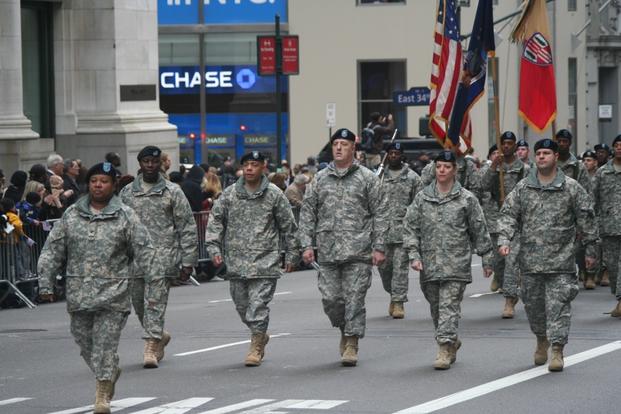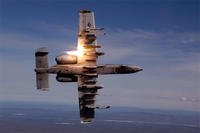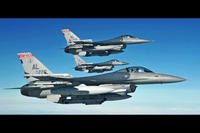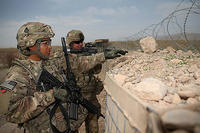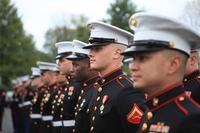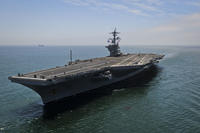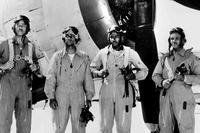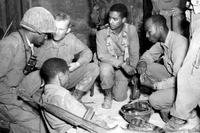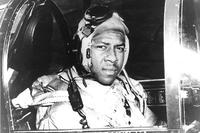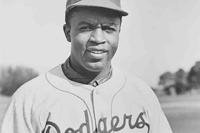Much has been written about the “Harlem Hellfighters” of the 369th Infantry Regiment during World War I, but little is known about the unit in subsequent conflicts. This article recounts the World War I story of the unit in honor of the war’s centennial and introduces the lesser-known tale of the 369th from the end of World War I and beyond and its later service as units of other branches of the Army, to include its current designation, the 369th Sustainment Brigade.
The 369th’s history begins with the organization of the 15th Infantry Regiment of the New York National Guard in 1916. Two hundred residents of Harlem formed the core of the regiment at first, though ultimately others joined from across New York City and other locales.
Soldiers of the 369th Infantry charge a German position during the Meuse-Argonne offensive on Sept. 29, 1918, in H. Charles McBarron’s painting, “Hellfighters” from Harlem. (National Guard Heritage Series)
With America’s entry into World War I on April 6, 1917, the regiment was federalized and later re-designated the 369th Infantry on March 1, 1918. The otherwise all-Black regiment fought to “make the world safe for democracy” in a segregated Army under the command of mostly white officers. The 369th trained primarily at Camp Whitman in Poughkeepsie, New York, and in South Carolina. After much debate about whether and how to use Black troops overseas, the 369th would be among the first American regiments to arrive in France.
While many Black soldiers in Europe would be assigned solely to support units, the 369th would see combat -- with a caveat. Originally assigned to the 185th Infantry Brigade, 93d Division (Provisional), Gen. John J. Pershing, commander of the American Expeditionary Forces, later assigned the 369th to the French 16th and 161st Divisions. With the French, the Harlem Hellfighters fought at Chateau-Thierry, Belleau Wood and many other locations.
While several members of the regiment received commendations for their service, the most lauded men of the 369th are probably Henry Johnson and Needham Roberts. In May 1918, the greatly outnumbered duo fended off a German patrol. Even when wounded and out of ammunition, they fought on and survived to become the first Americans, black or white, to receive the French Croix de Guerre. In 1996, both Roberts and Johnson posthumously received the Purple Heart. In 2002, Johnson, credited with rescuing Roberts, also would receive the Distinguished Service Cross, the citation for which tells the dramatic tale as follows:
The Distinguished Service Cross is presented to Henry Johnson, Sergeant, U.S. Army, for extraordinary heroism in action in France during the period 13-15 May 1918. Private Johnson distinguished himself by extraordinary heroism while engaged in military operations involving conflict with an opposing foreign force. While on a double sentry night duty, Private Johnson and a fellow soldier were attacked by a raiding party of Germans numbering almost twenty, wounding both. When the Germans were within fighting distance, he opened fire, shooting one of them and seriously wounding two more. The Germans continued to advance, and as they were about to be captured Private Johnson drew his bolo knife from his belt and attacked the Germans in a hand-to-hand encounter. Even though having sustained three grenade and shotgun wounds from the start, Private Johnson went to the rescue of his fellow soldier who was being taken prisoner by the enemy. He kept on fighting until the Germans were chased away. Private Johnson’s personal courage and total disregard for his own life reflect great credit upon himself, the 369th United States Infantry Regiment, the United States Army, and the United States of America.
A posthumous Medal of Honor followed for Johnson in 2015. All told, the 369th spent 191 days in combat, longer than any other American unit in the war. The U.S. Army Center of Military History (CMH) credits them with participation in the Champagne-Marne, Meuse-Argonne, Champagne 1918, and Alsace 1918 campaigns. The regiment also received the French Croix de Guerre with Silver Star. “My men never retire; they go forward or they die,” said their Commander, Col. William Hayward. Indeed, their reputation preceded them, and it was the Germans who first dubbed them the “Hellfighters.” Some 1,300 of those Hellfighters were casualties of war, according to Peter Nelson in the book "A More Unbending Battle: The Harlem Hellfighter’s Struggle for Freedom in WWI and Equality at Home."
Led by Lieutenant James Europe, the renowned 369th Regimental Band prepares to march in the 369th’s homecoming parade in New York City, Feb. 15, 1919. (National Archives)
When the 369th had departed New York City in December 1917, organizers had barred them from the farewell parade of New York’s other National Guard units, some of which made up the 42d “Rainbow” Division. As the men were told, “Black is not a color in the Rainbow.” When the now much-decorated 369th returned home in February 1919, however, crowds thronged New York City’s Fifth Avenue to see the victorious unit march to the music of their famed regimental jazz band leader, James Reese Europe. Those interested in reading more about the exploits of the 369th in World War I will find no shortage of books written on the topic.
The 369th Infantry demobilized on Feb. 28, 1919, at Camp Upton, New York, as part of the postwar drawdown. In 1924, the 369th was consolidated with the 15th Infantry, New York National Guard, and the consolidated unit reorganized in the New York National Guard as the 369th Infantry.
New York Times articles of the 1920s and 1930s depict the 369th as well-regarded and integrated into the fabric of both New York and military life. There were numerous mentions of the regiment taking part in standard field training maneuvers and parades. Veterans wrote editorials about their service in the World War.
Some of the 369th’s Gold Star mothers visited their sons’ graves in France. In January 1934, local officials dedicated a playground at 47 West 138th Street in Manhattan for William McCray, Company D, 369th Infantry, killed in action in France on Sept. 12, 1918. When 369th veteran George H. Gurley died that February, his employer, New York City Mayor Fiorello LaGuardia, marched “through slush and ice” at the head of his funeral procession.
Gov. Herbert H. Lehman, along with some 20,000 spectators, descended upon Camp Smith in Peekskill, New York, to review the unit that September, and other New York officials reviewed the troops regularly. In fact, LaGuardia told the 369th upon a review in May 1936, “I don’t think I’ve ever seen a regiment so well-equipped and so soldierly.” In 1937, the regiment received a Works Progress Administration-funded mural honoring “Negro Soldiers in the American Wars.” Men from all walks of life were proud to join the unit, with some even falsifying their age in order to enlist.
In the summer of 1938, Col. Benjamin O. Davis Sr. arrived to assume command of the 369th Infantry. On Oct. 25, 1940, President Franklin D. Roosevelt promoted Davis to brigadier general, making him the Army’s first Black general officer
The 369th Infantry marches by the reviewing stand in New York City as thousands of spectators line the parade route, Feb. 15, 1919. (National Archives)
The outbreak of war in Europe meant changes for the U.S. Army, even as Roosevelt pledged neutrality. The coming crisis would also spell big changes for the 369th. On Aug. 30, 1940, the 369th was reorganized and re-designated as the 369th Coast Artillery (Antiaircraft) and inducted into federal service on Jan. 13, 1941. The new 369th Coast Artillery was then sent to Fort Ontario in Oswego, New York.
Brig. Gen. George Jones, USA-Ret., recalled arriving in Oswego in January 1941. He was just a 17-year-old sergeant when the Army shipped him and about 1,800 other Black soldiers to the fort for training. “We came out of New York City and were all excited … then we stepped off the train, and the first guy out, we lost him in a mound of snow," Jones recalled. "It was cold; that was what I remember most.”
Although the surrounding town was overwhelmingly white, the men of the 369th frequented local establishments in their free time, and race relations were mostly cordial. The reported rape of a white woman, supposedly by a member of the 369th, in the winter of 1941 marked a low point in relations between the unit and the local community. The soldier was later exonerated.
The 369th spent some eight months at Fort Ontario practicing antiaircraft drills. According to Paul Lear, manager of Fort Ontario, “They would set up positions for the antiaircraft artillery [AAA] guns, and they’d shoot at targets towed by airplanes.” Jones was part of the unit’s searchlight battery, which lit up the sky so the gunners could shoot at incoming enemy planes. He recalled, “About March or April, we noticed that our [searchlight] positions had moved. The lights had been set up on frozen Lake Ontario. As the ice thawed, the positions had to be moved. We were thankful we found that out, or the equipment would have been inundated in water.”
In addition to training, the men found time to relax. For example, the soldiers enjoyed dancing with local girls at a club in town and perpetuating the famed 369th band of the World War I era. Newspapers across the country regaled readers with tales of the military’s own “boogie woogie unit” secreted away in Oswego.
In July 1941, Army inspectors called the 369th’s progress mobilizing for war at Fort Ontario “astonishing.” The local Oswego community turned out in force to see the unit on parade that July. When Gov. Lehman inspected the unit that month, it was led by Black officers, a change from the white leadership standard in the World War I era.
The 369th departed Fort Ontario in late summer 1941 for Camp Edwards, Massachusetts, but not before planning a parade and a variety show for the local Oswego community “in recognition of the many kindnesses shown them.” While one might question whether Tf the New York Times whitewashed relations between the 369th and the local white community, historians Beth Bailey and David Farber conclude in their book, "The First Strange Place: Race and Sex in World War II Hawaii": “In racial terms, the time in Oswego went well.” This experience stands in marked contrast to that of many Black troops stationed in the South.
In August 1940, the 369th Infantry was reorganized and re-designated as the 369th Coast Artillery Regiment. In the photograph, noncommissioned officers of the regiment prepare to board the USS Mount Vernon at the San Francisco Port of Embarkation for Hawaii, June 16, 1942. (National Archives)
Despite this apparent goodwill between the 369th and its host community in Oswego, not everyone was sold on the idea of Blacks in the military -- even in segregated units. New York Times reporter Hanson W. Baldwin, for example, disparaged Black troops, calling them, among other things, a “big and dangerous exception to the general high standard of the American soldier.” This attitude was not uncommon. In a scathing editorial in the fall of 1941, William H. Hastie, a Black and a civilian aide to Secretary of War Henry L. Stimson, blasted such insulting assessments. Hastie pointed specifically to the illustrious record of the 369th to reinforce his assertion that “the Negro’s record for heroism in combat runs throughout the history of the United States.” If the nation went to war, according to Hastie, it would be well-served by competent and prepared Black troops.
The 369th left Camp Edwards for California in the spring of 1942. Many of the men wound up camped, literally, in people’s backyards in the Los Angeles suburbs. George Benta of the 369th noted in an unpublished oral history interview, “It was a nice neighborhood, very nice neighborhood. The homes were gorgeous. Nothing but respect, they were very proud of us … I had no problem.” The 369th departed California for Hawaii from the San Francisco Port of Embarkation on June 16.
It should be noted that on Jan. 1, 1942, a second 369th Infantry Regiment was constituted in the Army of the United States. Activated on May 15, 1942, this regiment was assigned to the 93d Infantry Division and served in the Pacific Theater. Like the earlier 369th Infantry, this regiment was largely an all-Black unit. It did not share lineage with the Harlem Hellfighters and was disbanded on Aug. 4, 1952.
Race relations were much more fluid in Hawaii at this time than on the mainland. Bailey and Farber share that Samuel Wilder King, the delegate from Hawaii to the U.S. Congress before the war and later governor of the state, wrote in a 1939 article entitled, “Hawaii Has no Race Problem,” stating, “Today the races of Hawaii live together as one people, owning one common allegiance to the American nationality. Racial origin means nothing to the individual in his status as an American. Among the racial groups, there is mutual understanding and friendly sympathy. The spirit of Old Hawaii governs, and ‘race prejudice’ as such is not countenanced.’”
One might suspect a politician’s motives, but Bailey and Farber agree that the racial prejudices that did exist were largely imported from Southerners transplanted to the island for military or civilian jobs. The 369th, comprised mostly of New Yorkers unaccustomed to such overt prejudice and slights, brooked no insults, refusing to vacate sidewalks for whites, for example, and insisting that all men of lower rank salute them as military protocol demanded. As the 369th’s Hugh Harewood noted in an unpublished oral history interview, “We were from New York, and we didn’t take any crap from anybody. So anytime any of the Marines came by and they call us n------ or whatever, we ripped them … and it was so bad that I think what happened, when there was a new contingent of Marines that would come on the base, the lecture they would get is, don’t mess with those n------ over there. Don’t do that.”
After some physical confrontations, those whites inclined toward overt racism and confrontation with the 369th began to think better of it. Other Blacks stationed on the islands took to impersonating soldiers of the 369th when out on the town, knowing they would receive more respect if associated with the Harlem Hellfighters.
On Dec. 12, 1943, the regiment was broken up, with its elements used to form several other units, including the 369th AAA Gun Battalion and the 870th AAA Automatic Weapons Battalion. The 870th arrived on Okinawa on May 10, 1945, and took part in the Ryukyus campaign. The 369th landed in Okinawa on Aug. 12, after the fighting had concluded and just days before the Japanese announced their surrender.
There was no massive homecoming parade for the soldiers of the 369th after World War II, as there had been after World War I. The method of discharge adopted by the military differed in the latter conflict. After the earlier conflict, units were discharged as a whole. During World War II, soldiers were released according to a point system based on time in service, time overseas, decorations and dependents, so members of the 369th would have trickled back to their homes over an extended period of many months. As 369th veteran William DeFossett noted in an oral history interview, “We didn’t come home en masse. In other words, we came home. We came across country to Fort Dix, and this day they might discharge three of us and tomorrow discharge 20 more, it was spread out.”
Something that did mirror 1919’s return home was that veterans of the 369th -- along with some one million other Blacks who had served in uniform -- once again returned home from a world war to a country that was in many places segregated and racist. Postwar, though, the armed forces would become the first large national institution to desegregate when President Harry S. Truman signed Executive Order 9981 ordering them to do so. Reflecting on this, George Benta noted, “I hate to say this, but the war was a wonderful thing to happen, it was -- a lot of lives were taken, but I think it -- those of us who were sleeping in this country, it woke ‘em up; we can’t live like that. That’s the way I look at it.”
After World War II, the 369th underwent a series of reorganizations and re-designations. After service as New York Army National Guard AAA and later as field artillery units, it served as a transportation unit from 1968 to 1994. On Dec. 11, 1990, the 369th Transportation Battalion was ordered into federal service in support of Operation Desert Shield (and later Desert Storm).
For its service in Southwest Asia, the 369th was awarded credit for the Defense of Saudi Arabia, Liberation of Kuwait, and Cease-Fire campaigns. The battalion was released from federal service on July 8, 1991.
In 1994, the 369th was reorganized and re-designated as the 369th Support Battalion. On Dec. 7, 2003, the battalion was ordered into federal service in support of the Global War on Terrorism. It reverted to state control on June 3, 2005. On Sept. 1, 2006, the 369th Support Battalion was consolidated with the 10th Transportation Detachment, expanded, and reorganized and re-designated as the 369th Sustainment Brigade.
Today, the 369th is one of nine Army National Guard support units that provide fuel, ammunition, medical supplies, repair parts and other services to combat units. It proudly traces its heritage back to the 15th Infantry Regiment of the New York National Guard, that all Black unit organized in 1916 that would earn worldwide respect for its bravery and honor in World War I, and the nickname, the “Harlem Hellfighters.” It is still breaking down barriers.
Col. Stephanie Dawson, the first female brigade commander in New York Army National Guard history, assumed command of the 369th on Nov. 16, 2008, demonstrating that women, too, can be Hellfighters. One looks forward to following the trailblazing 369th’s exploits as it heads into its second century.
The Army Historical Foundation is tasked with building the National Museum of the United States Army in Fort Belvoir, Virginia. To learn more, visit www.armyhistory.org.
Want to Know More About the Military?
Be sure to get the latest news about the U.S. military, as well as critical info about how to join and all the benefits of service. Subscribe to Military.com and receive customized updates delivered straight to your inbox.
